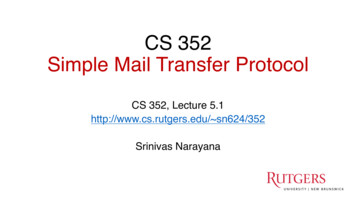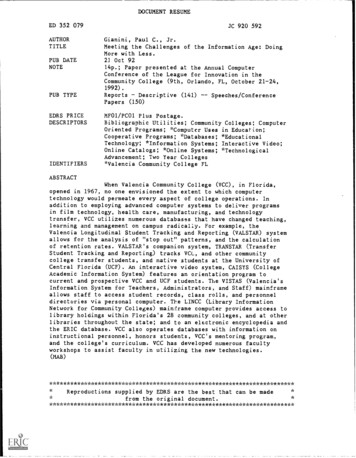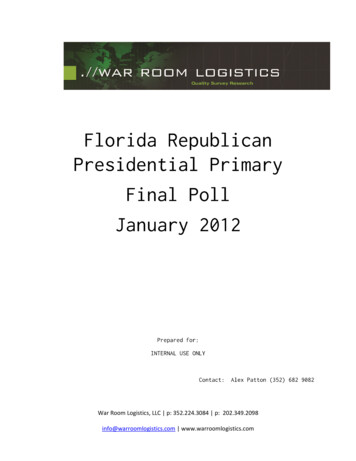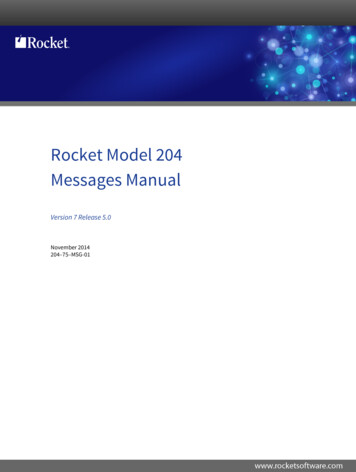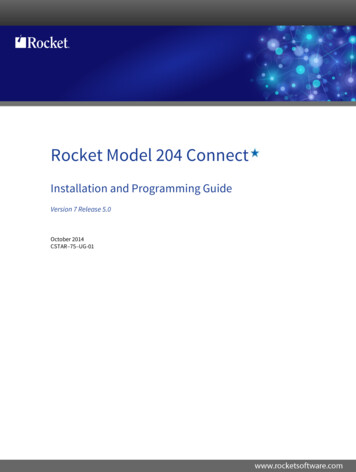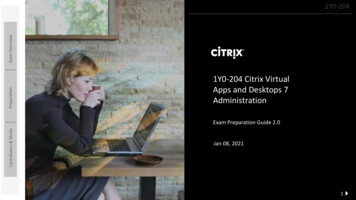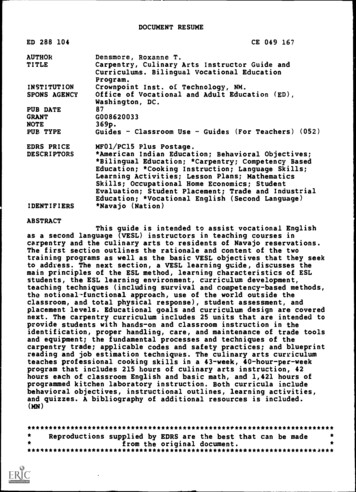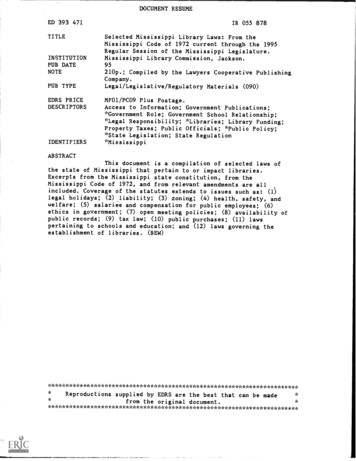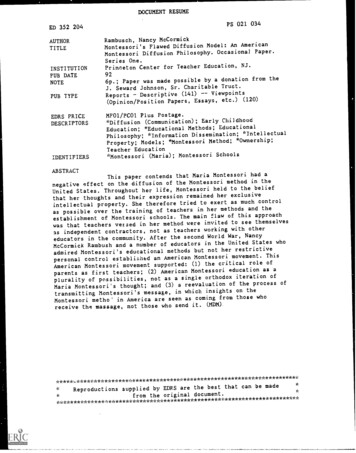
Transcription
DOCUMENT RESUMEPS 021 034ED 352 204AUTHORTITLEINSTITUTIONPUB DATENOTEPUB TYPEEDRS PRICEDESCRIPTORSIDENTIFIERSRambusch, Nancy McCormickMontessori's Flawed Diffusion Model: An AmericanMontessori Diffusion Philosophy. Occasional Paper.Series One.Princeton Center for Teacher Education, NJ.926p.; Paper was made possible by a donation from theJ. Seward Johnson, Sr. Charitable Trust.ViewpointsDescriptive (141)Reports(Opinion/Position Papers, Essays, etc.) (120)MF01/PC01 Plus Postage.*Diffusion (Communication); Early ChildhoodEducation; *Educational Methods; EducationalPhilosophy; *Information Dissemination; *IntellectualProperty; Models; *Montessori Method; *Ownership;Teacher Education*Montessori (Maria); Montessori. SchoolsABSTRACTThis paper contends that Maria Montessori had anegative effect on the diffusion of the Montessori method in theUnited States. Throughout her life, Montessori held to the beliefthat her thoughts and their expression remained her exclusiveintellectual property. She therefore tried to exert as much controlmethods and theas possible over the training of teachers in herestablishment of Montessori schools. The main flaw of this approachthemselveswas that teachers versed in her method were invited to seeworkingwithotheras independent contractors, not as teacherseducators in the community. After the second World War, NancywhoMcCormick Rambush and a number of educators in the United Statesrestrictiveadmired Montessori's educational methods but not herThispersonal control established an American Montessori movement.(1)thecriticalroleofAmerican Montessori movement supported:education as aparents as first teachers; (2) American Montessorisingleorthodoxiteration ofplurality of possibilities, not as aofMaria Montessori's thought; and (3) a reevaluation of the processinwhichinsightsonthetransmitting Montessori's message,Montessori metho' in America are seen as coming from those whoreceive the massage, not those who send it. **************************Reproductions supplied by EDRS are the best that can be madefrom the original ******************************
U.3. DEPARTMENT OF EDUCATION Mice of Educational Rsearch and ImprovementEDUCATIONAL RESOURCES INFORMATIONCENTER (ERIC)asO This document has been reproducedreceived from the Dotson or organizationoriginating itM,nor changes nave oeen made to improveproduction qualityPoints of new Of opinions steledin Misdocu.ment do not necessarily represent ()thewOERI POsition or colicvOAn occasional paper of theGtPrinceton Center for Teacher EducationtinSeries OneAn American Montessori Diffusion PhilosophyMontessori'sFlawed Diffusion ModelNancy McCormick Rambusch"PERMISSION TO REPRODUCE THISMATERIAL HAS BEEN GRANTED BYfAcisroc\cce.TO THE EDUCATIONAL RESOURCESINFORMATION CENTER (ERIC)."BEST CCM" AMBLE
An American Montessori Diffusion PhilosophyMontessori's Flawed Diffusion ModelNancy McCormick Rambusch.1111111sights, Maria Montessori held to thediscussion for almost half a century.Another was to provide her followersbelief throughout her life that herwith a flawed diffusion model.Like many purveyors of original inthoughts and their expression remainedher exclusive intellectual property.Correlatively, she believed that the circumstances surrounding the practice ofthe "method" associated with her nameought to be controlled by her personally. Thus did a cenacle of her disciplesorganize the Association MontessoriInternationale (AMI) in 1927 to insurethat this would happenIn effect,Montessori developed an internationalfranchise system for her educationalideas, managed by the AMI, in hername.Montessori expressed her professionalintentions publicly in her first book onwork done with the San Lorenzo slumchildren, A Method of Scientific Pedagogy as applied to Infant Education andthe Children's Houses. Anne George'sAmerican translation of the book jettisoned i'Ls cumbersome title which wasboth shortened and changed. It becameMontessori's proprietary lock on herideas and their expression caused consternation and puzzlement to Americans interested in her work on at leasttwo separate occasions. When S.S.McClure, editor of McClure's Maga-zine, arranged an American tour forMontessori in 1913, it was his intentionto participate in some kind of Americantraining effort, once Montessori's ideasbecome better known in the UnitedStates. McClure's enthusiasm forOne could argue thatat the moment Montessoriconsented to have her"method" identified as herpersonal property, herultimate effectiveness as aneducator .vas compromised.The Montessori Method (1912), andMontessori's method as a ''bestwas no longer identified as the methodof Scientific Pedagogy earlier described.Apparently Montessori both liked thecorded an article on her work which hadring of the new title, and lived andworked subsequently by its implications. Where Montessori had begun herwork as a disinterested researcher, opento the free inquiry of fellow researchersin the fields of physical anthropology,pediatric psychiatry and psychology,she diffused her educational work in aproprietary manner. One could arguethat at the moment Montessori consented to have her "method" identifiedas her personal property, her ultimateeffectiveness as an educator was compromised. One clear effect of her franchise strategy was to keep her workoutside the orbit of serious educationalselling"commodity had been heightened by the favorable reception acappeared earlier in his magazine. Enroute to America with McClure, Montessori apparently had second thoughtsabout his ambitions and reasserted theexclusivity of her insights in whatproved to be a habitual pattern.Retrospectively considered, a far greatermiscue on Montessori's part occurredwhen she rebuffed the cooperative ef-had, since Montessori was enragea thatthe Bell's would consider moving forward to implement such a project, with-out her express permission and presence. As a result of Montessori's reaction, the Bell's abandoned their interest in an American Montessori education (Rambusch, 1992).The pain Montessori trod in spreadingher ideas is one well known in westernculture. Donald Schon calls it the "center-periphery" model of innovation diffusion (Schon, 1964). It was used effectively by the Roman army, by Christianity and by Communism. It beginswith an acknowledged leader gatheringa group of chosen, uncritical disciplescommitted to the "work." These fan outto the antipodes of the known worldwith the "message." The converts stayconnected to the center of the enterpriseby standards of internalized "orthodoxy"supported by a hierarchical organization. This diffusion strategy, necessarily asymmetrical in character, consid-ers the natives to be in need of themissionaries' message. From the missionaries' perspective, the only freedom the natives enjoy is in acceptingthe message, not in reformulating it.If such a diffusion strategy is to work,the following conaitions must be obtained:The message must be fully articulated before it leaves the "center.There must be enough energy atforts of Alexander Graham Bell and hiswife to establish a Montessori teacherthe center to serve all of the pe-training facility in the United States.The center must be mindful ofBell saw global import in Montessori'swork. One can only speculate on theeffect such a collaboration might haveripheral points.information coming back from theperiphery and act upon it to modifythe central message.
Princeton Center for Teacher EducationMontessori's Flawed Diffusion Model : Rambuschloosely confederated under a headteacher or an administrator. WhereMontessori's thought and(3) the contextualizing and ultimatetransforming of Montessori's in-office and leaving the branch offices totheir own devices. Insufficient energyat the center, too many commitments toother alternative educational methods,parent cooperatives, teacher collectivesand Waldorf educators paid close attention to implementation of ideas incommunity, Montessori clearly neverconceived of collegial support as eitherdistant peripheral points, an unwillingness to accept feedback from thenecessary or relevant. Thus, inadvertently, did she sow seeds ofperiphery, all spell disaster.dissention and dysfunction as shadowelements in the implementation of herpedagogical messages. Paradoxically,one of the appeals of the Montessorimethod as an American public schoolalternative may well rest on the aforementioned flawed insight of Montessori. In the typical American publicelementary school, teachers are historically just as isolated and free standingin their self-perception, as are Montessori teachers through their training.If these conditions are not met, "implo-sion" occurs, wherein the center collapses in on itself and the peripheralpoints are left to fend for themselves.Think of it as closing down the homeApparently, it was Montessori's perception that if she, in her lifetime wasnot merely "at" the center of her enterprise but was "the" center, then whatever shifts in doctrine occurred couldbe managed easily as her furtherthoughts on the subject. Her sole propri-etorship of the diffusion network further insured orthodoxy, because onlyshe would determine who, among herdisciples, was worthy to transmit herdoctrine in Montessori's lifetime. Thisplan of action, coupled with the effectsof her isolation and two world wars,severely restricted the global impactshe had hoped to have. However, shewas able to manage what became infact, a successful family business de-In the late 1950's and 60's, those of uscentral to the development of the Ameri-can Montessori movement busied ourselves establishing an indigenous net-work of schools and teacher trainingprograms. We focused on implementingMontessori's message in an Americanvoted to teacher training in hersetting, rather than on analyzing"method," and upon her death be-Montessori's diffusion strategy. Montessori herself eschewed specificationqueathed that business, the AMI, to herson, Mario.Montessori's strongly individual styleappealed to Americans with their national penchant for "going it alone."Yet, an unanticipated long- term effectof Montessori's diffusion strategy wasthe flawed message of quasi-proprietorship given to the American teachers following hermethod. Each teacher,charged with diffusing "the method" toa particular group of youngsters, wasinvited to see herself as a free standingindividual, in relation to Montessori'sthought and to its implementation, not.as a teacher working together with otherteachers in community. From the late1950's on, American Montessorischools were typically composed ofgroups of teacher who perceived them-selves as independent contractors,of the particular cultural conditionsunder which her method flourished,claiming it could flourish under a diver-sity of conditions. We had no quarrelwith the "deposit" of Montessori truth,that is, the method as a complex ofinsights and strategies. We felt free toshape and interpret the contextual conditions in which schools would be situ-ated in the creation of the fledgingAmerican Montessori movement, threepeculiarly contextual articles of faithanimated our work:sights in America as rightfully coming from those receiving her "message," not those sending it.This last was particularly important.Whereas the first failed efforts at bring-ing Montessori education to Americawere those of Montessori herself and afew faithful American disciples, likeAnne George and Helen Parkhurst, thesecond impetus, which led to a stunningly successful institutionalization ofMontessori's "method" came aboutthrough my going to Europe, gettingthe "message" in the form of AMIteachertraining, and bringing it back asan American among the Americans whowould ultimately implement and diversify it.As a result of the inade:juacy ofMontessori's diffusion model for anAmerican audience, an American Mon-tessori diffusion strategy necessarilydeveloped. This model, based onpartnership, is not one of transmissionalone, but of transaction. Montessori,critical of the annihilating effects ofauthoritarian childrearing, utilized thatsame authoritarian model in transmitLing her message. She considered thereceivers of her message as blank slatesupon which she would write the salientword. The American Montessori response to Montessori's diffusion modelwas to develop one much more congru-ent with her educational philosophy.This model paid appropriate attentionto the receiver of her message as already possessing a life history worthyof consideration and incorporation intothe reeeivers iteration of AmericanMontessori education.(1) The critical role of parents as thechild's "first" teacher and as impor-Referencestant collaborators with teachers inchildren's education.Rambusch, Nancy M., "Montessori in(2) American Montessori educationas a plurality of possiblities, not as asingle "orthodox" iteration ofMontessori,Marla, The Montessori Method,New York: Frederick Stokes, 1912.America: A History" in Loeffler, Margaret(Ed.) Montessori in Contemporary AmericanCulture, Portsmouth, NH Heinemann, 1992.Schon, Donald A., Beyond the Stable StateNew York: Harper & Row, 1964.
Nancy McCormick RambuschNancy McCormick Rambusch is credited with the reintroduction of Montessori educationinto the United States, after the Second Word War. Dr. Rambusch founded the AmericanMontessori Society in 1960, and the first American Montessori Teacher Training programshortly thereafter. During her tenure as President of the fledging group, she was involved inthe establishment of more than 400 American Montessori schools. She is credited with thereformation of the Montessori method for the American audience.Dr. Rambusch is currently a professor of Early Childhood Education at the State Universityof New YOrk/College at New Paltz. She also serves as Director of Staff Development ofPrinceton Center for Teacher Education, Princeton, NJ.Princeton Center for Teacher EducationPC
DOCUMENT RESUME. ED 352 204. PS 021 034. AUTHOR Rambusch, Nancy McCormick TITLE Montessori's Flawed Diffusion Model: An American. Montessori Diffusion Philosophy. Occasional Paper. Series One. INSTITUTION Princeton Center for Teacher Education, NJ. PUB DATE. 92. NOTE 6p.; Paper was made possible by a donation from the. J. Seward Johnson, Sr. Charitable. Trust.

